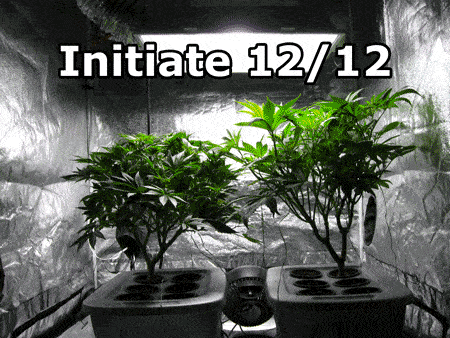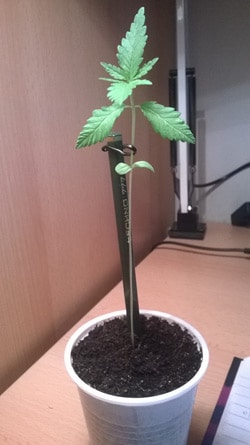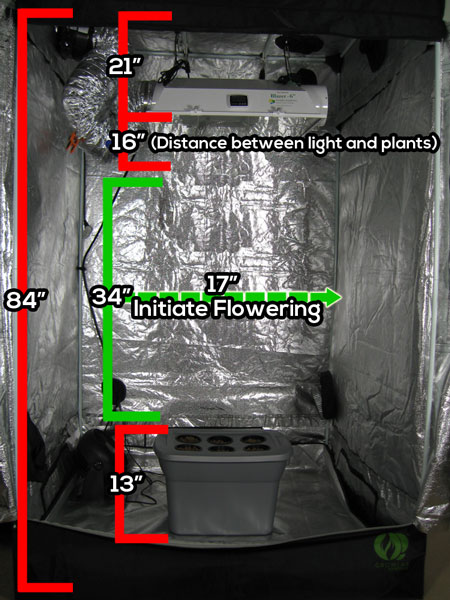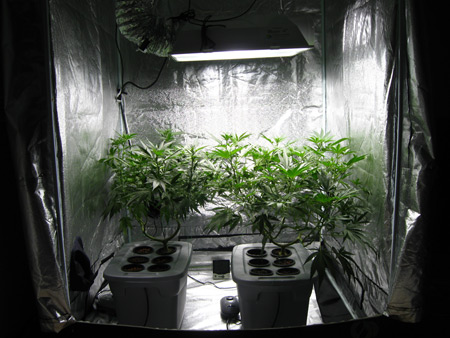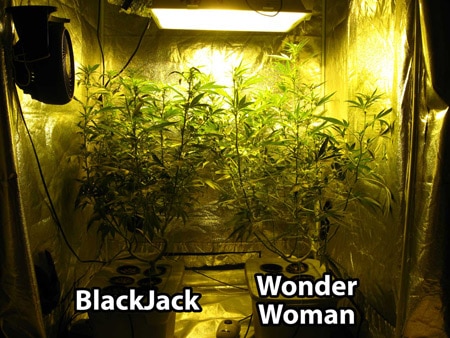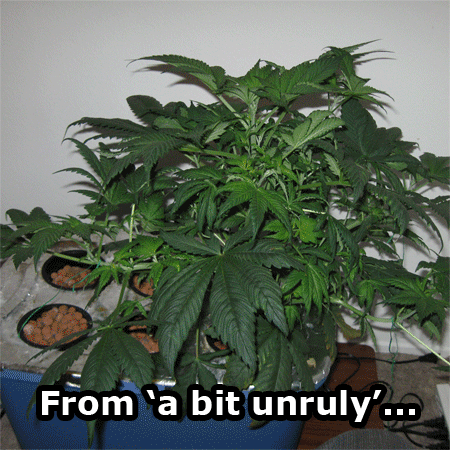by Sirius Fourside
Right around the time when kids start hitting middle schools, short awkward teenagers go through puberty and turn into taller awkward teenagers…or was that just me? I’m sure you knew of at least one kid who grew so much, they looked almost as if someone grabbed them by their head and feet and just stretched them out.
When cannabis plants start to mature, they also go through a brief transitional period; a sort of cannabis-puberty if you will. And just as humans undergo a burst of rapid growth, cannabis plants will also create a large portion of their final height in a very short period of time. This explosion of vertical grow this commonly called the cannabis ‘Flowering Stretch’.
What is the Flowering Stretch?
The best way to give you an idea is with pictures. Here’s a cool animated .gif Nebula made showing the flowering stretch in action.
Each strain is different. Notice how the plant on the right stretches much more than the plant on the left. It’s a good idea to match strains for height when possible, which helps ensure a similar amount of stretch.
This is a great example of how small or large a stretch can be. Notice that the plant on the left (818 Headband) gains only a few inches while the plant on the right doubles in size!
In short, the flowering stretch is a potential burst of rapid growth that happens shortly after switching to the flowering phase. It can be massive, or it can be next to nothing. The important thing is to expect that it might happen and have a plan ready in case it does. Luckily, most strains you buy from a seedbank are stabilized with details from the breeder on whether the plant will stretch a lot or a little (typically indicated by height, where “short” strains tend to stretch a little and “tall” strains tend to stretch a lot). This allows us to not only plan for a flowering stretch, but take advantage of it when it happens.
What to Expect
Depending on the strain you’re growing, you can expect a pretty wide range of stretching. Some strains can double their height or more, while some do almost nothing. However, if you know the name of the strain you’re growing, you can look up the breeder recommendations to get a good idea of what might happen. Additionally, there are other factors that can give you insight:
- Sativas – “Sativa” strains tend to grow taller, lanky stems even when trained; inch-for-inch they tend to stretch much more than an “Indica” strain.
- Strain height – Many breeders and seedbanks have the average height of their strains listed. Sometimes it’s as vague as “short – medium – tall”, but even that is enough to give you an idea of its growth characteristics. Expect “tall” strains to stretch a lot!
- Light type – Certain light types are more conducive to stretching than others. You can use the right light color spectrum (especially more blue) to help control growth characteristics and reduce stretching. More on that later…
- Light distance – Plants also stretch when they’re trying to get more light (like this plant below). As a result of this type of stretching, plants grow taller, but with fewer bud sites. Note that this is not the same thing as the flowering stretch, rather it’s a symptom of too-little light. Most growers want to avoid stretching caused by not enough light because it often results in less bud and potentially height problems.
This plant is getting tall because it needs more light
One of the main reasons it’s so important to know about stretching is that it can rapidly reduce the amount of space you have in your grow tent/area. If you’re growing in a space with limited height, a good stretch can make it so you no longer have room to raise your lights. This leads to light/heat stress and lost buds.
I personally had a stretch where there was no longer any room to raise the lights. The LEDs absolutely cooked the buds underneath it until I got desperate and cut the stuff that was too close. I would handle that situation differently now, but it shows that no one is immune if they’re unaware.
Planning for the Flowering Stretch
Planning for a stretch is easy to do when you know it’s a possibility. There are two things growers can do that will give a lot of control over planning for a potential stretching situation:
Research your strain
If you know what strain you’re going to grow, you can usually find its growth characteristics online. Seedfinder.eu is a pretty good resource for reviews on strains submitted by other growers. While it isn’t necessarily 100% accurate (what is?), it should give you a good range of what to expect. Knowing the strain you’re growing gives you the power to decide how much stretch you’ll deal with. Since stretching is often accompanied by a ‘tall’ final height, you can reduce stretch by getting plants that are characterized as being ‘medium’ or ‘short’.
Plan for a tall plant
In my opinion, the best way to be prepared for any stretch is to simply plan out the space as if you know that your plant will double in height by the end of flowering. Don’t worry, it’s much easier than it sounds! Here’s how you do it:
- Take the total amount of vertical (height) growing space you have in inches/cm.
- Take the total from #1, and subtract the height of your lights when it’s at its highest point.
- Next, subtract the height of the pot/container your plant will be in.
- Finally, subtract the amount of space you’ll need between your light and your plants.
- This varies depending on the lights; CFLs only need about 4″, HIDs need 12+”.
- When your plants height reaches half of the number you’re left with, initiate flowering!
Not too bad right? It’ll seem even easier with an example! Here’s how it would work for my tent (math is below the picture):
- I have a 7 foot tall tent which comes out to 84 inches. Total: 84 inches
- My lights and the stuff to hold them take up 21 inches. Total: 63 inches
- My container is 13 inches tall. Total: 50 inches
- I’m planning to keep 16 inches between my plants and the light. Total: 34 inches
- I flower my plants when they are about 17 inches tall.
Basically, determine the max room available for the plant and initiate 12/12 when it’s about half the final desired size.
You don’t always need the space when you plan like this, but it allows you to easily deal with the times when your sweet little babies turn into monsters like this:
Pre-Stretch
Post-Stretch
Reducing the Stretch
Since we know the factors that can lead to more stretching, reducing how much a plant stretches is just a matter of acting on those factors.
Genes – Indica plants tend to be shorter, so if you prefer Indicas and would like a short plant, you’re in luck. If you like Sativas and have limited height, there are many strains available that have a shorter finishing height. Again, you can usually find the heights of strains at the websites of breeders and seedbanks.
Light type – Did you know that some lights and spectrums cause more stretching than others?
- HPS (High-Pressure Sodium) grow lights encourage stretching. One way to combat extra stretching is to leave your MH (Metal Halide) bulb in for the first 2-3 weeks of flowering before switching to the HPS bulb.
- LEC grow lights encourage stretching but typically with a nice branch structure. That means problems can be avoiding by initiating flowering a little earlier. The bonus is this results in a quicker harvest.
- T5 (fluorescent) growers can use vegetative (6500K) bulbs to encourage plants to grow squatter for the first few weeks after 12/12, then switch to flowering (2700K) colored bulbs once the plants stop stretching.
- LEDs typically don’t produce an above-average amount of stretching in my experience, but every model is a little different. The more red in the spectrum (typically high-red LEDs appear yellow or pinkish), the more likely you may deal with extra stretching.
Light Distance – Keeping your lights the right distance away will ensure that your plants don’t have to stretch to get more light. Use the ‘hand test’ to make sure your lights are as close as they can be without harming your cannabis.
Hand test: Place one of your hands right over your plant with your palms facing downward. If the heat from your CFL or HPS lights is uncomfortably hot or painful to your hand, move the lights away an inch and try again. This test does NOT work for LED lights as some models run extremely cool.
Some General Rules About Light Distance:
- Fluorescent grow lights like T5s (or now-obsolete CFLs) should be kept a few inches from your plants.
- For MH/HPS lights it depends on the size of your light.
- For LEDs, it’s different for each model so you should always check the manufacturer’s specifications, but it’s generally recommended to keep most LEDs 18-24″ away, though some of the most powerful LED grow lights need to be kept even further away, and smaller ones can be kept closer.
Plant Training – Although training itself does nothing to slow down stretching, it does give growers a good way to manage it. For example, if branches are set to grow vertically by low-stress training, a stretch can actually be beneficial since so much of the plant will be receiving light. Plant training can come in the forms of low-stress training, manifolding, topping, fimming, and more. These techniques are used in the vegetative stage to get your plant to grow the way you want in the flowering stage.
Making the Stretch Your Friend
The flowering stretch is not necessarily a bad thing. As long as you know what to expect, you can use it to your advantage.
For those with taller grow spaces, such as tents or custom-made grow spaces with 6+ feet of vertical grow room, big stretching strains can actually be a part of your growing plan. A taller grow space lets you choose from taller strains, giving you more strain choice. Plus if you’re growing a short strain in a tall space, it could take a long time to fill up the whole tent. Since you increase yields by filling up the space under the light with many long bud sites, a taller strain can help you do that more quickly and efficiently in a big space.
On the flip side, if you have a short space, you can choose a strain that doesn’t stretch much if at all. This might let you maximize your grow space by spreading your plant out wide under the light during the vegetative stage, without having to worry about a plant that keeps getting uncontrollably taller and taller when you switch to the flowering stage.
The ‘Flowering Stretch’ is another piece of knowledge that makes growing cannabis much easier once you know about it. I’ll leave you with a picture of when I got blindsided by a stretch and had no idea what to do (yet again). Don’t let this happen to you, too!
Jump to…
Cannabis Growth Control – Topping & More
Top-Fed DWC Cannabis Setup Guide – Bubbleponics
Which Grow Light? | Marijuana Grow Light Guide
Cannabis Grow Journals – Full Grows in Pictures

